

2016 March 11
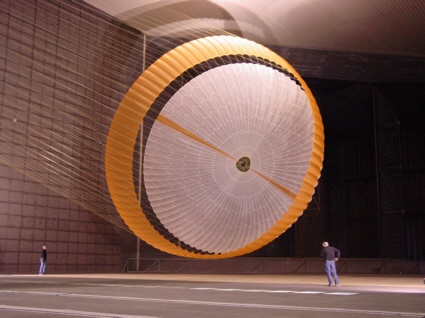
(DEC 26) The team developing the landing system for NASA's Mars Science Laboratory tested the deployment of an early parachute design in mid-October 2007 inside the world's largest wind tunnel, at NASA Ames Research Center, Moffett Field, California.
In this image, two engineers are dwarfed by the parachute, which holds more air than a 280-square-meter (3,000-square-foot) house and is designed to survive loads in excess of 36,000 kilograms (80,000 pounds).
The parachute, built by Pioneer Aerospace, South Windsor, Connecticut, has 80 suspension lines, measures more than 50 meters (165 feet) in length, and opens to a diameter of nearly 17 meters (55 feet). It is the largest disk-gap-band parachute ever built and is shown here inflated in the test section with only about 3.8 meters (12.5 feet) of clearance to both the floor and ceiling.
The wind tunnel, which is 24 meters (80 feet) tall and 37 meters (120 feet) wide and big enough to house a Boeing 737, is part of the National Full-Scale Aerodynamics Complex, operated by the U.S. Air Force, Arnold Engineering Development Center.
NASA's Jet Propulsion Laboratory, Pasadena, California, is building and testing the Mars Science Laboratory spacecraft for launch in 2009. The mission will land a roving analytical laboratory on the surface of Mars in 2010. JPL is a division of the California Institute of Technology.
Feature by NASA. Image courtesy NASA/JPL/Pioneer Aerospace
(DEC 26) Enjoy the free monthly astronomy program at the San Pasqual State Historic Park on Saturday, January 5, beginning at 5:00 p.m. Arrive early and get a seat on the bleachers for the night's sky orientation, followed by telescope viewing, weather permitting. Presented by the astronomers of OPTAS (www.optastroclub.com).
San Pasqual Battlefield State Historic Park is located at 16666 San Pasqual Valley Rd, just 1.5 miles east of the San Diego Wild Animal Park. For directions and a calendar of events, visit http://www.AQUATest.org
Dennis Mammana
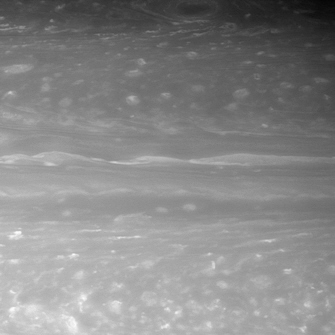
NASA's Cassini spacecraft provides a view of a transitional region of Saturn's atmosphere at 44 degrees north latitude where long, linear clouds are flanked by more turbulent swirls. The image was taken on November 8 with the spacecraft's narrow-angle camera and a deep red filter. The Jet Propulsion Laboratory, a division of the California Institute of Technology in Pasadena, Calif. manages the mission for NASA. Image courtesy NASA/JPL/Space Science Institute
(DEC 21) An asteroid discovered by The University of Arizona's Catalina Sky Survey has a one-in-75 chance of hitting Mars Jan. 30, scientists tracking it say. More
The Red Planet won't be this big and bright again until 2016.
(DEC 17) WAUKESHA, WI -- Christmas Eve will bring a lot more than Santa this year. Mars shines brightest and remains visible all night when it reaches opposition December 24. That night, the Red Planet shines brighter than any star; only the Full Moon and Venus will outshine it. An opposition occurs when Mars lies opposite from the Sun, becoming fully illuminated. Mars' oppositions happen roughly every 780 days.
Mars won't be this big or bright again until 2016. No equipment - just warm clothes - will be needed to enjoy this spectacle.
The Full Moon helps observers find Mars. On December 23, the Moon sits just 1° from the planet. One degree is equal to 2 Moon-diameters.
Even under urban skies with heavy light pollution, it will be easy to see martian details with a small telescope.
Mars will look almost as bright several weeks before and after December 24. Let Santa be the only one to worry if Christmas Eve presents a cloudy sky.
Astronomy Magazine

A favorite target of astrophotographers, M51 or the "Whirlpool Galaxy, assumes a different appearance in this multispectral view released by JPL on December 10. The composite combines images from different parts of the spectrum from several NASA spacecraft. X-ray data from the Chandra X-ray Observatory reveals point-like sources (purple) that are black holes and neutron stars in binary star systems and a diffuse glow of hot gas in the space between the stars. Optical data from the Hubble Space Telescope (green) and infrared emission from the Spitzer Space Telescope (red) highlight long lanes of stars and gas laced with dust in the spiral arms. The GALEX telescope shows hot, young stars that produce lots of ultraviolet energy (blue). The Spitzer and GALEX missions are managed for NASA by JPL in Pasadena, Calif. Image courtesy Jet Propulsion Laboratory, California Institute of Technology, and Infrared Analysis and Processing Center
(DEC 14) VANDENBERG AFB, Calif., December 14, 2007 - The Defense Meteorological Satellite Program (DMSP) F-18 Block 5D-3 spacecraft, built under contract for the U.S. Air Force by Lockheed Martin Space Systems Company, Sunnyvale, Calif., has been delivered to Vandenberg Air Force Base, Calif., in preparation for a July 2008 launch. More
One of the year's best meteor showers, the Geminids, promises lots of shooting stars. Observers under dark skies could see 100 or more meteors per hour.
(DEC 12) WAUKESHA, WI -- The annual Geminid meteor shower, which peaks the night of December 14/15, is typically one of the year's best. Occurring less than a month after the Leonids, the Geminid shower generally features brighter meteors. In 2007, the Moon will be a waxing crescent setting in midevening, so its light will have little effect on viewing.
Geminid meteors are relatively slow moving, and many leave smoke trails that can last a few seconds. In 2007, the shower will be active from about December 7 to 17, but the peak (the best time to see them) occurs the night of December 14 and the morning of December 15. The Geminid meteor shower has a broad peak, so observers should see an excellent show all night.
"The Geminid meteor shower usually produces a good percentage of bright meteors," says Astronomy magazine Senior Editor Michael Bakich, "so it's worth watching even under less-than-favorable conditions. In 2007, however, conditions are excellent."
Astronomy Magazine
Italy's COSMO-2 satellite rides into orbit aboard a Boeing Delta II rocket following liftoff from Vandenberg AFB on December 8. Brian Lockett photographed the event from the mountains west of Santa Barbara using two cameras to record different phases of the launch. He joined the resulting photos, creating this panorama (click to enlarge) that shows the launch from liftoff through first stage shutdown. Copyright 2007, Brian Lockett. Used with permission
(DEC 8) VANDENBERG AFB, Calif. - Vandenberg AFB successfully launched a Delta II rocket today at 6:31 p.m. The rocket took off from Space Launch Complex-2 carrying the Thales Alenia-Space COSMO-SkyMed 2 Satellite.
Col. Steve Tanous, 30th Space Wing commander, was the spacelift commander for this mission, or final go-for-launch authority.
"This was the second successful COSMO-SkyMed launch from Vandenberg Air Force Base this year," Colonel Tanous said. It takes a great deal of communications and teamwork to make a launch happen and the use of the Western Range by our Italian partners is rewarding for Team Vandenberg."
The Delta II is an expendable launch, medium-lift vehicle. It carries civil and commercial payloads into low-earth, polar, geosynchronous transfer and stationary orbits. The COSMO-SkyMed 2 satellite is an end-to-end Earth observation dual-use (civilian and military) system composed of four satellites and ground stations.
Vandenberg AFB
(DEC 7) VANDENBERG AFB, Calif. - The launch of a Delta II rocket has been rescheduled for Saturday at 6:31 p.m. due to high winds. The team could not ensure that winds would remain below the 31 knots allowable for a safe launch.
The rocket will lift off from Space Launch Complex-2 carrying the Thales Alenia-Space COSMO-SkyMed 2 Satellite.
This will be the second of two COSMO-SkyMed satellite launches from Vandenberg this year. The satellite is an end-to-end Earth observation dual-use (civilian and military) system composed of four satellites and ground stations.
Vandenberg AFB
(DEC 7) The sun is near the lowest ebb of the 11-year solar cycle and, until now, 2007 has been a year of very few sunspots. Enter sunspot 978: It popped over the sun's eastern limb yesterday and is quickly becoming a behemoth. The rapidly growing sunspot group is more than five times wider than Earth, making it an easy target for properly-filtered backyard telescopes. So far sunspot 978 poses little threat for strong solar flares, but this could change if the active region's development continues apace.
www.SpaceWeather.com
(DEC 5) LEXINGTON, Ky. - A rehearsal to the launch of the KySat satellite is sending a prototype on a suborbital flight between 11 a.m. and 1 p.m. (ET) today at a launch range at White Sands, N.M.
KySat, a collaboration between the University of Kentucky, Morehead State University, the University of Louisville, Murray State University, Western Kentucky University, the Kentucky Community and Technical College System and the Kentucky Science and Technology Corp., will establish Kentucky's place in the Space Age when it is put in permanent orbit sometime in the next 18 months.
Today's launch, which can be followed in an online Weblog, is testing a system that will permit the ground crew, headed by Jim Lumpp, associate professor of electrical and computer engineering at UK, to monitor onboard conditions on the rocket in the rehearsal.
Students on the collaborating team at White Sands are from the participating universities.
University of Kentucky

On November 28 the University of Arizona released several recent Mars Reconnaissance Orbiter HiRISE camera images including this view of the edge of Mars' south polar cap. The relatively bright, grayish areas are the residual cap, and the darker, reddish areas are probably covered by dust. The south polar residual cap is made mostly of carbon dioxide ice and dust with a little water ice in some places. HiRISE was built by Ball Aerospace and Technologies Corp., of Boulder, Colo., and is operated by the University of Arizona. Image courtesy of NASA/JPL/University of Arizona
(NOV 29) More than 260 planets have already been discovered orbiting other stars, and new ones are found almost every month. Having trouble keeping track? Help is on the way. More
(NOV 28) A stellar prodigy has been spotted about 450 light-years away in a system called UX Tau A by NASA's Spitzer Space Telescope. Astronomers suspect this system's central sun-like star, which is just one million years old, may already be surrounded by young planets. More
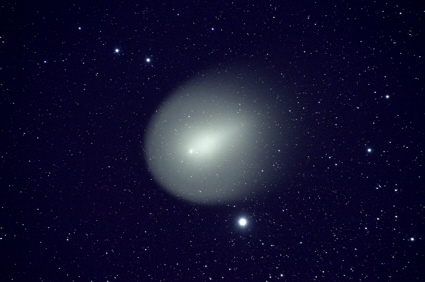
Comet Holmes may be dimming, but it's still proving to be photogenic as shown in this excellent photo taken by Rick Baldridge on November 20. Baldridge recorded the image near Los Gatos, California using a 4-inch refracting telescope and Canon Digital Rebel XTi camera. Copyright 2007, Rick Baldridge. Used with permission
(NOV 20) The next time you take a moonlit stroll, or admire a full, bright-white moon looming in the night sky, you might count yourself lucky. New observations from NASA's Spitzer Space Telescope suggest that moons like Earth's - that formed out of tremendous collisions - are uncommon in the universe, arising at most in only 5 to 10 percent of planetary systems. More
(NOV 18) The Mount Wilson Observatory Association invites the public to join them at their Annual Meeting, 2:30 p.m. on Sunday, November 25, at the Altadena Public Library. MWOA Vice President Mike Simmons will speak on "A Century of Solar Observing at Mount Wilson Observatory."
The talk will highlight major discoveries in solar astronomy made at Mount Wilson, beginning with the completion of the Snow Telescope in 1905. Simmons will also discuss long-term projects - something Mount Wilson has always excelled at. Instrumentation used in the Mount Wilson solar programs will also be described. Refreshments will be available at 2:00 P.M.
The Altadena Public Library is located at 600 E. Mariposa Street in Altadena.
Mount Wilson Observatory Association
Tropical Cyclone Sidr moves northward over the Bay of Bengal towards the mouths of the Ganges river. The Moderate Resolution Imaging Spectroradiometer (MODIS) on NASA's Terra satellite acquired this photo-like image (click to enlarge) at 10:15 a.m. local time (04:45 UTC) on 2007 November 14. Sidr appears here as a well-developed and distinct ball of circling clouds; the storm has a distinct but cloudy eye at its center. An extended arm of clouds reaches northward from the storm across Bangladesh, bringing the influence of the storm onshore already even though it was hundreds of kilometers to the south. Terra was launched into orbit in 1999 from California's Vandenberg AFB.
(NOV 15) HUNTSVILLE, Ala. - NASA and industry engineers successfully tested the main parachute for Constellation Program rockets during a drop test Thursday at the U.S. Army's Yuma Proving Ground near Yuma, Ariz. More
(NOV 14) WAUKESHA, WI - Skygazers can catch 10 to 15 shooting stars streaking through the early morning sky each hour November 18. This marks the peak of the annual Leonid meteor shower, best known for occasionally spectacular shows. More
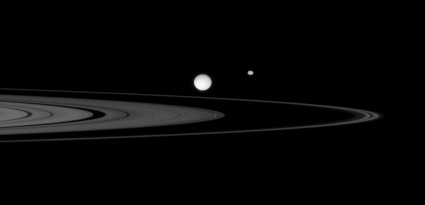
The Cassini spacecraft observes a gathering of moons near the rings of Saturn. Mimas, the largest, sits on the side of the rings nearer to Cassini. Oblong Epimetheus lies on the distant side of the narrow F ring. Tiny Daphnis lies to the lower right of Mimas, but is invisible in this view. JPL in Pasadena, Calif. designed and built Cassini's cameras and manages the mission for NASA. Image courtesy NASA/JPL/Space Science Institute.
(NOV 9) The annual Northern Taurid meteor shower caused by Comet Encke peaks on Nov. 12th. Although Taurid rates are normally low, only about five meteors per hour, those five can be doozies. The shower is a well-known producer of slow, bright fireballs visible at all hours of the night. If you're outside after dark this weekend, be alert for Taurids.
SpaceWeather.com
(NOV 8) The most energetic particles in the universe - ultrahigh-energy cosmic rays - likely come from supermassive black holes in the hearts of nearby active galaxies, says a study by scientists from nearly 90 research institutions worldwide, including the University of Utah. More
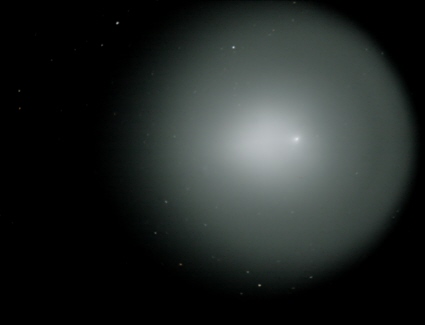
Ginger Mayfield took advantage of Divide, Colorado's dark skies on November 4 to create this view of Comet Holmes. Details in the comet's large coma, or head, are visible along with numerous background stars shining through the coma. Mayfield used a 14.5-inch Starmaster telescope and Canon EOS 30D camera to record multiple images of the comet and software to combine them into a single image. Copyright 2007, Ginger Mayfield. Used with permission
(NOV 4) Comet Holmes, a celestial visitor that should only be visible in large telescopes, has suddenly brightened and is now visible from the suburbs with the naked eye. This interesting object is conveniently placed in the sky and fairly easy to find.
To find Comet Holmes, go outside a couple of hours after sunset and face between north and northeast. Locate the W-shaped constellation Cassiopea. Then look to the lower right at the 5 o'clock position for the constellation Peseus, a fainter grouping of stars.
Carefully search Perseus for a fuzzy patch. If you find one, it's probably the comet. If you can't find the comet with the naked eye, try using binoculars.
The webmaster spotted Comet Holmes from the suburbs last night. The object was faintly visible to the unaided eye, but was easily seen with binoculars which revealed a very large head, but no tail.
(OCT 30) MOFFETT FIELD, Calif. - NASA has announced its intent to establish a new lunar science institute. This effort, with dispersed teams across the nation, will help lead the agency's research activities for future lunar science missions related to NASA's exploration goals. More
Multiple wildfires (red areas) and vast plumes of smoke plague southern California in this Terra satellite image (click to enlarge) taken before noon on 2007 October 23. The National Interagency Fire Center reported that 12 large, uncontained wildfires had burned over 335,000 acres in southern California. The fires spread due to fierce, dry Santa Ana winds. Image courtesy NASA/MODIS Rapid Response
(OCT 12) BEALE AIR FORCE BASE, Calif -- The 7th Space Warning Squadron's Upgraded Early Warning Radar recently guided an interceptor to track and destroy a test missile 230 kilometers above the Earth's surface. More
(OCT 23) BOULDER--In a landmark test flight, the National Center for Atmospheric Research (NCAR) and a team of research partners this month successfully launched a solar telescope to an altitude of 120,000 feet, borne by a balloon larger than a Boeing 747 jumbo jet. More

Haze collected over northern India, near the border with Nepal, on 2007 October 15 when the MODIS instrument on NASA's Aqua satellite took this picture. The red dots are hotspots, temperature anomalies detected by the sensor, likely caused by fires. Aqua was launched from California's Vandenberg Air Force Base in 2002. Image courtesy Jeff Schmaltz, MODIS Land Rapid Response Team, NASA GSFC
This annual display of shooting stars should provide a couple of dozen fast-moving meteors per hour when it peaks October 21.
(OCT 18) WAUKESHA, WI - Although the Moon will be bright early in the evening, prospects look good for the peak of this year's Orionid meteor shower October 21.
"This year's Orionids peak on a Saturday night and Sunday morning," said Astronomy's senior editor Michael E. Bakich. "That makes it easier to organize a family viewing session. Take a simple star chart with you, and identify some stars and constellations. It's fun and easy to do between bright meteors."
Streaking swiftly across the sky, tiny bits of rock and metal burn up as meteors. Although Earth constantly sweeps up interplanetary dust, our planet runs through a slightly denser trail this month. Astronomers call this event the Orionid meteor shower, named after the constellation from which the meteors appear to radiate.
The radiant - the point in the sky where the meteors seem to come from - lies in northeastern Orion the Hunter, where that constellation borders Gemini the Twins. The Orionid's radiant rises before midnight and stands high in the south by 4 A.M., a full 2 hours before dawn.
This year, the radiant couldn't be easier to find. It lies 10° south of orange Mars. (You can estimate 10° by holding your fist at arm's length. Its width, from little finger to thumb, equals about 10°.) Mars, at magnitude -0.4, shines brighter than any nearby star except Sirius, which lies 40° south.
Astronomy Magazine
(OCT 15) WASHINGTON - NASA is extending, for a fifth time, the activities of the Mars Exploration Rovers, Spirit and Opportunity. The decision keeps the trailblazing mobile robotic pioneers active on opposite sides of Mars, possibly through 2009. More
Layers inside Holden Crater in the southern hemisphere of Mars are shown in enhanced color in this image (click to enlarge) from the High Resolution Imaging Science Experiment (HiRISE) camera on NASA's Mars Reconnaissance Orbiter. The photo was one of 143 HiRISE color images released on October 10. The photos reveal features as small as a desk and are valuable to researchers studying possible landing sites for NASA's Mars Science Laboratory, a rover set for launch in 2009. HiRISE is operated by the University of Arizona and was built by Ball Aerospace and Technology Corp., Boulder, Colo. Image courtesy NASA/JPL/University of Arizona
(OCT 12) The Mount Wilson Observatory Association (MWOA) invites the public to join them at their monthly lecture/meeting, 2:30 p.m. on Sunday, October 28, at the Altadena Public Library. Caltech's Mike Brown will speak on "How I Killed Pluto and Why It Had It Coming."
For the past seven years, Dr. Brown and his associates have scanned the skies for planets beyond Pluto. In 2005, after a search of about half of the sky and the discovery of dozens of objects almost the size of Pluto, they found Eris, the first object larger than Pluto, and the first that might have been called a new planet. The discovery drives home the need to answer the question "What is a planet?". Brown will discuss the story of the discovery and why the question of planethood is difficult and why a new class of dwarf planets was created to describe all of these objects.
This event will be held in the Community Room of the Altadena Public Library, 600 E. Mariposa St. in Altadena. Refreshments are served at 2:00 p.m. followed by the program.
Mount Wilson Observatory Association
(OCT 9) NASA's Dawn spacecraft successfully completed the first test of its ion propulsion system over the weekend. The system is vital to the success of Dawn's 8-year, 1.6 billion-kilometer (3-billion-mile) journey to asteroid Vesta and dwarf planet Ceres. More
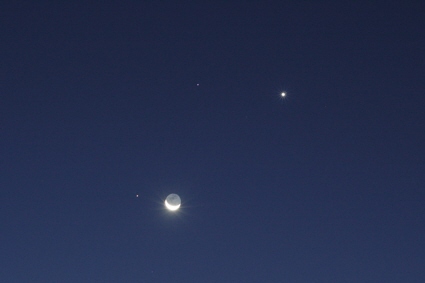
On October 7, early risers were treated a rare double conjunction, or pairing. Dazzling Venus (top right) paired up with the star Regulus while the waning crescent Moon passed one degree from Saturn. The webmaster recorded the view from southern California using a Nikon D70 digital SLR, 50mm lens, and 4-second exposure at ISO 400 and f/5.6. Copyright 2007, Brian Webb
(OCT 2) SANTA CRUZ, CA--A massive project to map a distant region of the Universe in multiple wavelengths--from x-rays through ultraviolet, visible, infrared, and radio waves--is releasing its data this week to both fellow scientists and the general public. More
(OCT 2) To say the least, it was incredible. The news relayed by the voice on the other end of the phone line hit the president of the San Gabriel Valley Radio Club like a blow to the head. Too incredible, Henry Richter hoped, to be true. More
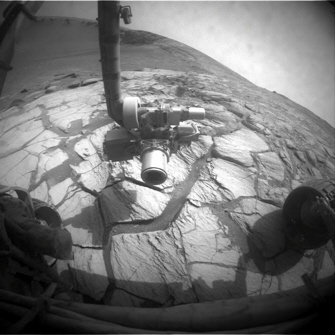
A layer of light-toned rock exposed inside Mars' Victoria Crater appears to mark where the surface was when an impact excavated the crater. NASA's Opportunity Mars rover took this image on September 25 when it drove to the bright band, the first stop on its investigation of the crater's interior. The rovers robotic arm is visible in the foreground. The Opportunity mission is managed for NASA by the Jet Propulsion Laboratory, a division of the California Institute of Technology. Image courtesy NASA/JPL-Caltech
(SEP 28) The Missile Defense Agency (MDA) announced today it has completed an important exercise and flight test involving a successful intercept by a ground-based interceptor missile designed to protect the United States against a limited long-range ballistic missile attack. More
(SEP 27) VANDENBERG AIR FORCE BASE, Calif. - The Missile Defense Agency is scheduled to conduct a test of the ground-based interceptor system between 1 and 5 p.m. here Friday.
During the evaluation, an interceptor launched from the Ronald W. Reagan Missile Defense Site here will be tested against a target missile, launched from Alaska's Kodiak Island.
The main objective of Friday's test will be to exercise the operational configuration of the interceptor missile.
Vandenberg AFB
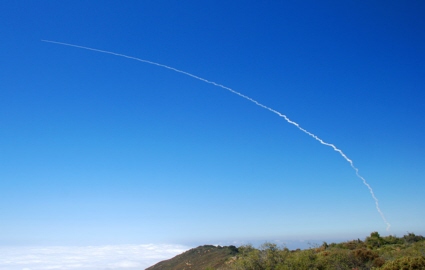
The WorldView-1 Earth imaging satellite heads downrange following liftoff from Vandenberg AFB on September 18. A Boeing Delta II rocket successfully inserted the spacecraft into a near-polar orbit. Colorado-based DigitalGlobe will use WorldView-1 to provide government and civil customers with imagery with a resolution of 0.5-meters (less than 19-inches). Photo Copyright 2007, Brian Lockett. Used with permission
(SEP 21) PASADENA, Calif.-- NASA has given the go-ahead to restart an astrophysics mission that will provide a greater capability for using high-energy Xrays to detect black holes than any existing instrument has. More
(SEP 18) Longmont, Colo. - DigitalGlobe, provider of the world's highest-resolution commercial satellite imagery and geospatial information products, today announced the successful launch and deployment of WorldView-1, the most agile commercial satellite ever flown. The satellite launched at approximately 11:35 AM PDT on a Boeing Delta II 7920 rocket from Vandenberg Air Force Base in California, USA. More
This stunning close-up of Saturn's moon Iapetus shows mountainous terrain that reaches about 6 miles (10 kilometers) high along the moon's equatorial bulge. The image was taken with the Cassini spacecraft's narrow-angle camera during a close flyby of Iapetus on September 10. Above the middle of the image an impact has exposed the bright ice beneath the dark overlying material. The Cassini orbiter and its onboard cameras were designed, developed and assembled at JPL in Pasadena, Calif. The imaging operations center is based at the Space Science Institute in Boulder, Colo. Image courtesy NASA/JPL/Space Science Institute
(SEP 14) VANDENBERG AIR FORCE BASE, Calif. - Vandenberg is scheduled to launch a Boeing Delta II rocket carrying the DigitalGlobe WorldView-1 satellite, Tuesday between 11:35 and 11:49 a.m. from Space Launch Complex-2 on north Vandenberg.
Col. Stephen Tanous, 30th Space Wing commander, will be the spacelift commander for this mission.
The WorldView-1 satellite will provide high-resolution images of Earth.
This launch will take place on the Air Force's 60th Anniversary. In its short but noble history, the Air Force has established itself as the preeminent provider of Air and Space and Cyberspace capabilities.
Vandenberg AFB
(SEP 11) MOFFETT FIELD, Calif. - NASA is collaborating with Russia on a new robotic mission to conduct biological studies. The Russian Foton-M3 mission is scheduled for launch Sept. 14, 2007, from Kazakhstan, and NASA scientists will participate in several of the mission's experiments. More
Hurricane Henriette churns off the west coast of Mexico in this thermal image (click to enlarge) from NASA's Aqua spacecraft. Aqua's Atmospheric Infrared Sounder (AIRS) instrument recorded the view during an early morning pass over North America on September 5. The category 1 hurricane was 60 miles (100 km) north-northeast of La Paz with sustained winds of 75 miles (120 km) per hour. Areas with the lowest temperatures are purple while the warmest temperatures are orange or red. The AIRS instrument is managed for NASA by JPL in Pasadena, Calif. Image courtesy NASA/JPL-Caltech
(SEP 4) PASADENA, Calif. - Astronomers from the California Institute of Technology and the University of Cambridge have developed a new camera that produces much more detailed pictures of stars and nebulae than even the Hubble Space Telescope, and it does all this from here on Earth. More
(SEP 4) SANTA CRUZ, CA--A $600,000 gift from the Gloria and Kenneth Levy Foundation will help fund an integral part of the Automated Planet Finder now being built at the University of California's Lick Observatory. More
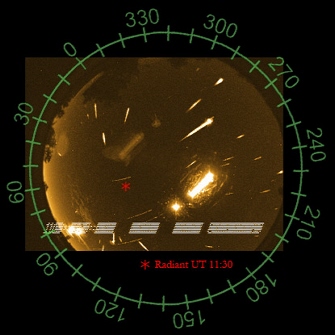
Several Aurigid meteors flash across the sky in this composite image by Chris Peterson. Usually a minor meteor shower, the Aurigids produced a rare burst of activity on the morning of September 1. This view combines 49 meteor images collected the night of August 31-September 1 from Guffey, Colorado. According to Peterson, nearly all of the meteors appeared between 04:40 and 05:40 MDT (10:40-11:40 UTC) and the shower's radiant (point of origin) is obvious in the image. Copyright 2007, Chris Peterson. Used with permission
(AUG 27) ST. LOUIS, -- The Boeing Company [NYSE: BA] has been awarded an $8.9 million U.S. Air Force contract to study key elements of a conventional prompt global strike missile demonstration.
The study, scheduled to be completed by June 2009, will help plan for a demonstration using a land-based Minotaur launch system and a payload delivery vehicle designed to carry and deliver various conventional payloads at global ranges in less than one hour of flight time. The contract is managed by the U.S. Air Force's Space and Missile Systems Center at Los Angeles Air Force Base.
The Air Force selected the Minotaur launch vehicle for a demonstration because of its near-term asset availability and low-cost profile.
Boeing has played a key role in missile development design, production and maintenance since the conceptualization of Minuteman I in 1958. In addition to the Guidance Replacement Program, Boeing performs guidance repair activities at its Guidance Repair Center in Heath, Ohio, and is an ICBM Prime team member.
Boeing
(AUG 27) BOULDER--Scientists for the first time have observed elusive oscillations in the Sun's corona, known as Alfvén waves, that transport energy outward from the surface of the Sun. The discovery is expected to give researchers more insight into the fundamental behavior of solar magnetic fields, eventually leading to a fuller understanding of how the Sun affects Earth and the solar system. More
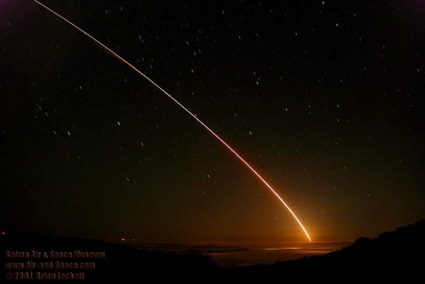
A Chimera missile lights up the clouds and heads downrange following liftoff from Vandenberg AFB on August 23. The modified Minuteman II ICBM blasted from silo LF-06 at north base and flew a ballistic arc before splashing in the Pacific. The launch coincided with the flyby of the military's NFIRE satellite, which gathered images and other data of the event. Data from Wednesday's 25 million dollar experiment will be used to develop future missile defense systems. Photo Copyright 2007, Brian Lockett. Used with permission
(AUG 22) PASADENA, Calif.- Panoramic images of the sky obtained at Palomar Observatory are a major part of "Sky in Google Earth," a new product released today by Google Inc. Sky in Google Earth contains images of the entire celestial sphere, showing hundreds of millions of stars, galaxies, and other cosmic wonders. More
(AUG 22) VANDENBERG AIR FORCE BASE, Calif. - Team Vandenberg is scheduled to perform a launch to support the Near Field Infrared Experiment (NFIRE) boost phase missile defense data collection effort on Aug. 23, with a launch window from 1 to 5 a.m.
The launch is set to occur after having been delayed so that program officials could continue to optimize data collection equipment on board the orbiting NFIRE satellite. Program officials want to be very precise in preparing for the missile launch due to the fact that the overall objective is to collect as much data as possible from the boosting missile.
The primary mission of the NFIRE satellite is to collect high and low resolution images of a boosting rocket to improve understanding of missile exhaust "plume" observations and plume-to-rocket body discrimination during three plume signature types: targets of opportunity, dedicated missile fly-bys, and ground observations.
The collected data will be used in the development effort for boost phase missile defense technology, which will help to develop missile defense systems capable of shooting down a hostile ballistic missile within the first few minutes after it is launched.
Vandenberg AFB
The Zaca Fire rages though the Los Padres National Forest north of Santa Barbara, California in this view (click to enlarge) recorded on August 12 when the fire was an estimated 84,000 acres. This image of the fire captured by NASA's Terra satellite shows thick smoke blowing north and several actively burning areas, which are outlined in red. The spacecraft's launch site, Vandenberg AFB, is to the left where a line of clouds meets the coast. Image courtesy Jeff Schmaltz, MODIS Land Rapid Response Team, NASA GSFC
(AUG 17) VANDENBERG AIR FORCE BASE, Calif. - The scheduled missile launch from Vandenberg AFB, Calif. on August 19, to support the Near Field Infrared Experiment (NFIRE) boost phase missile defense data collection effort has been delayed so that program officials can continue to optimize data collection equipment on board the orbiting NFIRE satellite.
Program officials want to be very precise in preparing for the missile launch due to the fact that the overall objective is to collect as much data as possible from the boosting missile.
The collected data will subsequently be used in the development effort for boost phase missile defense technology, which will help to develop missile defense systems capable of shooting down a hostile ballistic missile within the first few minutes after it is launched.
Vandenberg AFB
(AUG 15) NASA's Galaxy Evolution Explorer has spotted an amazingly long comet-like tail behind a star streaking through space at supersonic speeds. The star, named Mira after the Latin word for "wonderful," has been a favorite of astronomers for about 400 years. More
Human families may be bonded by blood, but stellar families are united by gravity. In this image (click to enlarge), NASA's Spitzer Space Telescope spots the Serpens South star cluster, which consists of a relatively dense group of 50 young stars -- 35 of which are protostars, or stars that are just beginning to form. Stellar members of the cluster are the green, yellow, and orange specks atop the black dust lane running down the center of the image. Green represents hot hydrogen gas excited when high-speed jets of gas ejected by infant stars collide with the cool gas in the surrounding cloud. The wisps of red are organic molecules (polycyclic aromatic hydrocarbons) excited by stellar radiation from a neighboring star-forming region. The Spitzer mission is managed by the Jet Propulsion Laboratory in Pasadena, Calif. Image courtesy NASA/JPL-Caltech/ L. Allen (Harvard-Smithsonian CfA) & Gould's Belt Legacy Team
(AUG 9) MOFFETT FIELD, Calif. -- When space shuttle Endeavour rocketed into space yesterday, it took along a common microorganism normally found in the upper respiratory tract of approximately 40 percent of the healthy human population. More
(AUG 6) An international team of astronomers using a network of small automated telescopes in Arizona, California, and the Canary Islands have discovered the largest known exoplanet. More
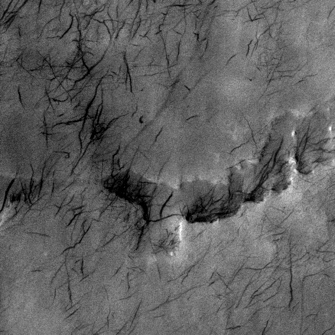
Martian dust devils leave their mark on Argyre Basin in this recently released NASA Mars Odyssey spacecraft image. The tracks (short, dark lines) were recorded by the craft's Thermal Emission Imaging System (THEMIS), which was jointly developed by Arizona State University and Raytheon Santa Barbara Remote Sensing.
(AUG 3) Early Tuesday morning, August 28th, a colorful lunar eclipse will be visible from five continents including most of North America. More
(JUL 30) BOULDER, Colo. - Ball Aerospace & Technologies Corp. has successfully completed assembly and performance testing of WorldView I, the remote sensing satellite built for DigitalGlobe®. Ball Aerospace and DigitalGlobe have completed their comprehensive pre-shipment review and the satellite is now being made ready for delivery to California's Vandenberg Air Force Base for a mid-September launch. More
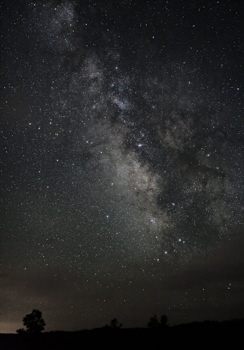
A hallmark of summer, the Milky Way hangs above the southern horizon of Park County, Colorado. Ginger Mayfield took this guided photo of our galaxy using a Canon 30D digital camera and 24-70mm zoom lens set at 24mm. The 45-second exposure was made at f/2.8 and ISO 1600. Copyright 2007, Ginger Mayfield. Used with permission
(JUL 23) University of Arizona astronomers who are probing the oxygen-rich environment around a supergiant star with one of the world's most sensitive radio telescopes have discovered a score of molecules that include compounds needed for life. More
The solar system's innermost planet gives early risers an observing treat
(JUL 23) WAUKESHA, WI - Mercury, the swiftest planet in the solar system, makes a brief morning showing shortly before dawn. Your best chance to catch a glimpse of this elusive world comes between July 18 and 28.
"Observers must make a special effort to see the planet," Astronomy magazine Associate Editor Frank Reddy says.
Of all the planets, Mercury orbits closest to the Sun. This small, fast orbit is what makes seeing Mercury such an observing challenge. Because the planet never strays far from the Sun, it always appears in bright twilight. And even when Mercury is best placed for observers, the fleet-footed planet doesn't remain there long. To catch Mercury, skywatchers need to know exactly when and where to look.
"Even the best view is fleeting," Reddy says, "but in the challenge lies the reward. Catch a glimpse of Mercury, and you're seeing a world 38-percent Earth's size that orbits the Sun four times each year."
Astronomy Magazine
Fire activity ramped up across the U.S. West near the end of the third week of July. Dry thunderstorms (lightning and winds, but no rain) ignited hundreds of fires in a matter of days. This image of Nevada was captured by the MODIS instrument on NASA's Aqua satellite on July 18. Actively burning fire are outlined in red. Dark brown burn scars dot the buff-colored landscape, while thick smoke stretches north from the fires. Many of the fires are burning along the Interstate 80 corridor; the highway is dotted with small towns that fall along its path: Wells, Elko, Beowawe, Battle Mountain. Image courtesy of MODIS Rapid Response Team, NASA Goddard Space Flight Center
(JUL 16) VANDENBERG AIR FORCE BASE, Calif. -- Launch Facility 5 rests high on a plain on North Base overlooking many miles of Vandenberg's coastline. At one time, it was an active Peacekeeper missile silo. Now, three missile maintainers are working on the silo's surface, participating in an exercise of international proportions. More
(JUL 16) WASHINGTON - NASA has signed a $1.2 billion contract with Pratt and Whitney Rocketdyne Inc., of Canoga Park, Calif., for design, development, testing and evaluation of the J-2X engine that will power the upper stages of the Ares I and Ares V launch vehicles. More
Scientists at Arizona State University are using the THEMIS instrument on NASA's Mars Odyssey orbiter to map and monitor a large dust storm on the Red Planet. The maps, such as this one (click to enlarge), show the atmosphere's opacity in the infrared and are color coded with nearly clear areas indicated in purple and those with roughly a two-thirds reduction in sunlight shown in red. The storm erupted during late June and has spread around the planet's southern hemisphere and has also drifted into the north. The dust is affecting operations for all five U.S. and European five spacecraft operating at Mars. Image courtesy NASA/JPL/Arizona State University
(JUL 11) Got a calendar? Circle this date: Sunday, August 12th. Next to the circle write "all night" and "Meteors!" Attach the above to your refrigerator in plain view so you won't miss the 2007 Perseid meteor shower. More
(JUL 11) PASADENA, Calif.- Using natural "gravitational lenses," an international team of astronomers claim to have found the first traces of a population of the most distant galaxies yet seen-the light we see from them today left more than 13 billion years ago, when the universe was just 500 million years old. More
On July 1, NASA's Aqua satellite took this image (click to enlarge) of the plume from Klyuchevskaya Volcano on Russia's Kamchatka Peninsula. The multi-spectral MODIS instrument image actually shows two plumes. The larger, more visible plume is almost white, indicating a high water vapor content. The less visible plume is dark brown, suggesting that it consists primarily of volcanic ash. Aqua was launched from California in 2002. Image courtesy Jeff Schmaltz MODIS Land Rapid Response Team, NASA GSFC
(JUL 4) PASADENA, Calif. - NASA's Cassini spacecraft has revealed for the first time surface details of Saturn's moon Hyperion, including cup-like craters filled with hydrocarbons that may indicate more widespread presence in our solar system of basic chemicals necessary for life. More
(JUL 3) Oceanside Photo & Telescope will hold its third annual Southern California Astronomy Exposition (SCAE 2007). Join them July 14 for a day filled with stimulating talks on some of the most exciting topics in astronomy, followed by a night under the stars with experienced amateur astronomers. On July 28 enjoy the Telescope Demonstration & Raffle which will feature the largest and most exciting names from the telescope industry. For more information and schedule of events, visit: http://www.optcorp.com/scae.aspx
Dennis Mammana
On June 11 the cameras on the Aeronomy of Ice in the Mesosphere (AIM) satellite returned some of the first data (click image to enlarge) documenting noctilucent or "night-shining clouds" over the Arctic regions of Europe and North America. This new data reveals the global extent and structure of these mysterious clouds to a degree that was previously unattainable. White and light blue represent noctilucent cloud structures. AIM was launched on April 25 aboard a Pegasus XL rocket released from a jumbo jet flying off the California coast. Image courtesy University of Colorado Laboratory for Atmospheric and Space Physics
(JUN 28) PASADENA, Calif. - NASA's Mars rover Opportunity is scheduled to begin a descent down a rock-paved slope into the Red Planet's massive Victoria Crater. This latest trek carries real risk for the long-lived robotic explorer, but NASA and the Mars Rover science team expect it to provide valuable science. More
Appearing together for one night, the two planets will put on a nice evening show.
(JUN 26) WAUKESHA, WI - Families can cap off a fun-filled weekend by seeing Venus and Saturn close together in the evening sky July 1.
For about 2 hours after sunset, the two planets appear separated by about 1˝ Full-Moon widths (0.8°) from our perspective on Earth. Astronomers call such a close pairing a conjunction.
A planetary conjunction occurs when a planet is aligned from our line of sight with another object, such as a star, the Moon, or another planet.
Venus and Saturn, located in Leo the Lion, make a stunning show as darkness falls. Venus glows low in the west at magnitude -4.6, the brightest "star" after sunset, while Saturn shines 120 times fainter but still bright enough to see without the aid of binoculars or a telescope. All viewers, not just seasoned astronomers, can enjoy this planetary display.
Astronomy Magazine
The Space Shuttle Atlantis (click image to enlarge) touches down at California's Edwards AFB on June 22, concluding the 13-day STS-117 mission to the International Space Station. Atlantis was originally slated to land at Kennedy Space Center in Florida, but was diverted to Edwards due to weather. NASA photo by Carla Thomas
(JUN 19) The Quick Scatterometer (QuikSCAT) satellite built by Ball Aerospace & Technologies Corp. and launched from Vandenberg AFB, has completed eight years of on-orbit operations and continues to return data on marine storms, El Nino, and polar ice sheets. More
(JUN 18) NASA's recent test of the first nanotechnology-based electronic device to fly in space could lead to improved environmental monitors and smoke detectors in future crew habitats. More
Four moons accompany Saturn's brilliant rings in the high-resolution version of this Cassini spacecraft photo (click to enlarge) released June 13. Visible from lower left to center right are Mimas, Janus, Pandora , and Prometheus. The narrow F ring lies between the latter two, which are its "shepherd moons". The image was taken with Cassini's wide-angle camera some 1.2 million miles (1.9 million kilometers) from the planet. The spacecraft and its two onboard cameras were designed, developed and assembled at the Jet Propulsion Laboratory in Pasadena, Calif. Image courtesy NASA/JPL/Space Science Institute
(JUN 13) BERKELEY - A paper in this week's issue of Nature by University of California, Berkeley, geophysicists demolishes one of the key arguments against the past presence of large oceans on Mars. More
(JUN 13) The New Mexico State University Astronomy Department will hold a night-sky viewing open house at 8:30 p.m. Friday, June 22, at the NMSU on-campus Tombaugh Observatory.
Weather permitting, visitors will observe the moon as well as the planets Venus, Jupiter and Saturn. The Ring Nebula, Globular Star Cluster 13 and many other celestial bodies also may be seen.
Nancy Chanover, college assistant professor of astronomy at NMSU, will be on hand to host the open house. She will be joined by astronomy graduate students Allison Widhalm, Mike Sussman and Joe Wellhouse.
The open house is free and open to the public. Children are encouraged to attend. For more information contact the astronomy department at (505) 646-4438.
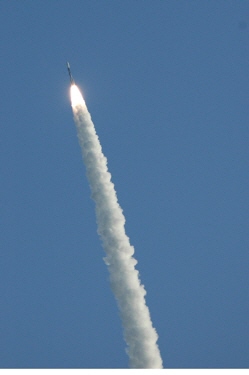
A Boeing Delta II rocket climbs following lift-off from Vandenberg Air Force Base on June 7. The rocket later inserted Italy's COSMO-1 Earth observation satellite into a 335 by 341-mile high polar orbit. Copyright 2007, Matt Batryn. Used with permission
(JUN 10) A Delta II rocket carrying an Italian satellite was successfully launched from Vandenberg AFB on June 7. The rocket lifted-off from Space Launch Complex 2-West at 19:34 PDT, the end of 13-minute launch window. The Boeing booster later inserted Italy's COSMO-1 radar imaging satellite into a polar orbit.
After the spacecraft begins operation, its X-band synthetic aperture radar will provide military and civil users with high-resolution images of any point on Earth.
The launch was observed over a wide area of southern California, but was difficult for many observers to see because the Sun was above the horizon, or worse, was in the same general direction as the rocket.
After sunset, an interesting display occurred when lingering rocket exhaust was illuminated by the Sun, producing a tenuous, glowing cloud. The cloud was probably produced by residue from the Delta's solid rocket motors.
Brian Webb
(JUN 7) Preparations are underway at Vandenberg Air Force Base for this evening's launch of a Delta rocket ... the 7:21 p.m. lift-off will place an Italian eye-in-the-sky into orbit. Listen
Courtesy KCLU public radio
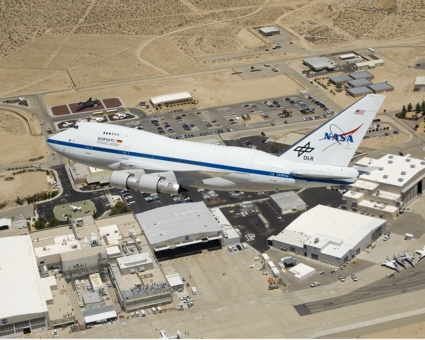
NASA's Stratospheric Observatory for Infrared Astronomy, or SOFIA, arrives at NASA's Dryden Flight Research Center at Edwards Air Force Base, Calif. The heavily modified Boeing 747SP was ferried to Dryden May 31 from Waco, Texas, where L-3 Communications Integrated Systems installed a 2.5-meter infrared telescope and made other major modifications over the past several years. SOFIA will undergo system installation and integration and flight testing at Dryden and eventually provide astronomers with access to the visible, infrared and sub-millimeter spectrum. Image courtesy NASA Dryden Flight Research Center
(MAY 31) ATLANTA - An international team of scientists working at Georgia State University's Center for High Angular Resolution Astronomy (CHARA) telescope array in California's San Gabriel Mountains have captured a picture of Altair, one of the brightest stars visible from Earth and one of the closest at 15 light years away. More
(MAY 30) HONOLULU, Hawaii--An astronomer at the California Institute of Technology has discovered three giant stellar streams arcing high over the Milky Way. Remnants of cannibalized galaxies and star clusters, the streams are between 13,000 and 130,000 light-years distant from Earth and extend over much of the northern sky. More
Fires and smoke were widespread across southern Mexico and northern Central America in mid-May 2007. This image (click to enlarge) from the MODIS instrument on NASA's Aqua satellite shows places where the sensor detected actively burning fires on May 22 marked in red. May 4 marked the fifth anniversary of the spacecraft's 2002 launch from Vandenberg AFB. Image courtesy Jeff Schmaltz MODIS Land Rapid Response Team, NASA GSFC
(MAY 25) NASA has awarded the University of Colorado at Boulder $1.2 million to design and build a rocket payload to probe a nearby interstellar cloud with new technology that may help scientists better understand the mass and evolution of distant galaxies. More
(MAY 25) Technical problems forced officials to cancel this morning's scheduled lift-off an anti-missile interceptor from Vandenberg Air Force Base. The launch was part of an $85 million test of the U.S. missile defense system that called for the launch of a target missile carrying a mock warhead from Kodiak, Alaska followed by lift-off of the interceptor from Vandenberg. The interceptor was to home-in on the approaching warhead and destroy it in a high-speed collision above the eastern Pacific.
However, the target missile malfunctioned after launch and the test was aborted. A Missile Defense Agency team is investigating the target missile anomaly and the test will be rescheduled for a later date.
Brian Webb
(MAY 23) VANDENBERG AIR FORCE BASE, Calif. - The scheduled Missile Defense Agency ground-based interceptor system test was delayed due to weather constraints in Alaska. The test was rescheduled to Friday with a launch window from 7 to 11 a.m.
During the evaluation, an interceptor launched from the Ronald W. Reagan Missile Defense Site here will be tested against a target missile, launched from Alaska's Kodiak Island.
The main objective of the test will be to exercise the operational configuration of the interceptor missile.
Vandenberg AFB news release
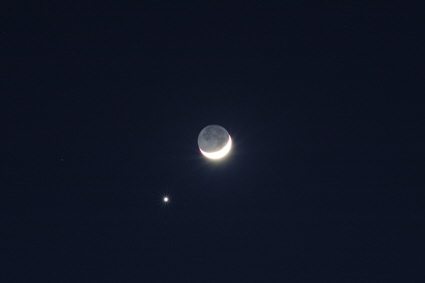
Observers in western North America were treated to a splendid display on May 19 when the Moon passed close to Venus. The two objects were separated by less than one degree, but Venus was actually several million miles behind the Moon. The webmaster recorded the display from Ventura County, California with his Nikon D70 digital camera with a 180mm lens. The exposure was 4-seconds at f/5.6 and ISO 400. Copyright 2007, Brian Webb
(MAY 18) The University of Colorado at Boulder has signed an initial partnership agreement to participate in the design and construction of a 25-meter, far-infrared telescope that will be located in the Chilean desert to probe the distant galaxies, stellar nurseries and outer reaches of the solar system. More
(MAY 14) SANTA CRUZ, CA--Astronomers have used powerful adaptive optics technology at the W. M. Keck Observatory in Hawaii to reveal the precise locations and environments of a pair of supermassive black holes at the center of an ongoing collision between two galaxies 300 million light-years away. More
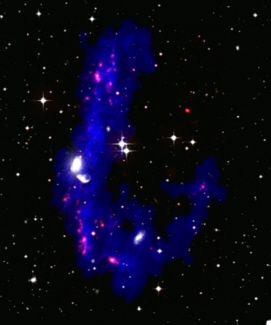
The galaxy NGC 5291 and surrounding dwarf galaxies and gas 200 million light-years from Earth shine in this multiwavelength image released May 10. The blue, white, and red areas represent features detected in the radio, optical, and ultraviolet portions of the spectrum, respectively. The large blue region is atomic hydrogen seen with the Very Large Array (VLA) radio telescope in New Mexico while many of the red blotches are dwarf galaxies observed with the UV-sensitive GALEX spacecraft. The image was created as part of a study of dwarf galaxies formed from the debris of a collision of larger galaxies. Image courtesy P-A Duc, CEA-CNRS/NRAO/AUI/NSF/NASA
(MAY 9) A team that includes researchers from the University of Arizona reports that supersonic are winds blasting through the atmosphere of an exoplanet planet 60 light years from Earth. More
(MAY 8) DENVER - A NASA spacecraft touched down on the coast of Florida after a brief 3-1/2 hour trip from the foothills of the Rocky Mountains, but the spacecraft's next and final trip will be a 9-1/2 month journey to Mars. More

Veteran astronaut Walter M. "Wally" Schirra, Jr. died of natural causes May 2 in California at age 84. A naval aviator and test pilot, he was a member of the first group of U.S. astronauts. Schirra was the only astronaut to fly in all three of the first U.S. manned space programs (Mercury 8, 1962; Gemini 6, 1965; and Apollo 7, 1967). From 1969 to 1975 he teamed with CBS anchorman Walter Cronkite on television creating a powerful space-coverage duo. Schirra resided in Rancho Santa Fe, California at the time of his death. Image courtesy of NASA.
(MAY 4) REDONDO BEACH, Calif. -- NASA's Aqua satellite, built by Northrop Grumman Corporation (NYSE:NOC), marked its fifth year on-orbit today observing the Earth's water systems, producing a massive data flow that is giving the world's scientists insight into the Earth's climate. Aqua was launched from Vandenberg Air Force Base, Calif., on May 4, 2002. More
(APR 30) NASA's Jet Propulsion Laboratory in Pasadena, Calif., invites the public on a "Journey To the Planets and Beyond." The laboratory will open its doors during its annual Open House on Saturday and Sunday, May 19 and 20, from 9 a.m. to 5 p.m. More
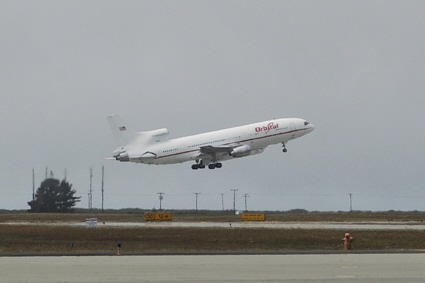
An L-1011 jumbo jet with a Pegasus XL rocket mounted on its belly takes-off from Vandenberg AFB on April 25. The rocket was later released 39,000 feet above the Pacific 75 miles southwest of Monterey and successfully carried NASA's Aeronomy of Ice in the Mesosphere (AIM) satellite into a polar orbit. Copyright 2007, Brian Webb
(APR 26) All eyes are on the sun (though not directly with the naked eye) now that the NOAA-led Solar Cycle 24 Prediction Panel released its official consensus solar cycle forecast at the Space Weather Workshop in Boulder, Colo., yesterday. More
(APR 25) The clock is counting down for this afternoon's launch of a NASA satellite off of the Central Coast ... the $140-million mission will study mysterious clouds at the edge of space. Listen
Courtesy KCLU public radio
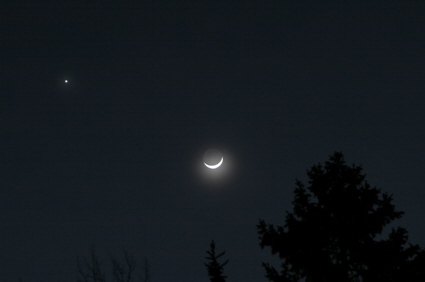
The Moon and Venus paired up on April 19 when the Moon's orbit carried it within several degrees of the planet. Ginger Mayfield recorded the dusk display in this one second exposure taken from Divide, Colorado. Copyright 2007, Ginger Mayfield. Used with permission.
(APR 19) VANDENBERG AIR FORCE BASE, Calif. - Vandenberg is scheduled to launch an Orbital Sciences Pegasus XL vehicle Wednesday, April 25 carrying NASA's Aeronomy of Ice in the Mesosphere (AIM) spacecraft. The Pegasus launches from beneath an L-1011 carrier aircraft which will depart Vandenberg's runway before dropping its payload approximately 100 miles west-northwest of the base. The launch window extends from 1:23 to 1:30 p.m. The last Pegasus launch was March 22, 2006 carrying NASA's Space Technology 5 spacecraft into orbit.
Vandenberg AFB
(APR 17) WAUKESHA, WI - National Astronomy Day takes place April 21, and Astronomy magazine and Meade 4M again join forces with the country's most prestigious science museums to put on the year's biggest star party.
As families prepare for their summer camping trips, National Astronomy Day provides the perfect opportunity for them to learn about how to observe shooting stars, planets, and comets in the coming months.
Experts at 28 locations - including Chicago, Miami, Oakland, Portland, and San Diego - across the nation will inspire and engage kids and adults with hands-on activities, demonstrations, presentations, telescope observing, and more. These activities will showcase the visually stunning and mind-boggling events of deep space.
The list of participating science museums and more information about this program can be found at http://www.astronomy.com/astronomyday.
Astronomy Magazine
The Pleiades star cluster, a frequent target for astrophotographers, takes on a different appearance in this recently released infrared image (click to enlarge) from NASA's Spitzer Space Telescope. The view is a composite of images taken at wavelengths of 4.5, 8.0 and 24.0 microns and highlights the spider-web-like network of filaments (yellow, green and red in this view) made up of dust associated with the cloud through which the cluster is traveling. The Spitzer mission is managed for NASA by the Jet Propulsion Laboratory in Pasadena, Calif. Image courtesy NASA/JPL-Caltech/J. Stauffer (SSC/Caltech)
(APR 15) Astronomy enthusiast Carmelita Miranda of Fillmore, California was recently recognized by having an asteroid renamed in her honor. Asteroid (48416) Carmelita was discovered on 1988 January 24 by C. S. Shoemaker and E. M. Shoemaker at Palomar observatory.
The Minor Planet Circular announced the naming and provided the following citation: "Carmelita Miranda (b. 1950) developed a love of astronomy while sailing the Pacific. She focused this passion into writing and presenting night-sky programs to over 25,000 children using a portable planetarium."
Miranda is an avid amateur astronomer and astrophotographer and is married to comet expert Charles Morris.
(APR 11) WASHINGTON - NASA is preparing to launch the Aeronomy of Ice in the Mesosphere (AIM) spacecraft, the first mission dedicated to exploration of mysterious ice clouds that dot the edge of space in Earth's polar regions. More

Ray White Jr. (1933-2004) stands next to the University of Arizona's 21-inch optical telescope that will be renamed the "Raymond E. White Jr. Reflector" in his honor on April 23. The instrument is housed in the historic 1923 Campus Station dome on the west side of Steward Observatory. White, who joined the UA astronomy faculty in 1964, helped shape UA astronomy curriculum and hosted the UA Steward Observatory Public Evening Lecture Series. Image courtesy University of Arizona.
(APR 6) MOFFETT FIELD, Calif. - NASA scientists have discovered evidence that a mysterious red glow, seen throughout the Milky Way and other galaxies but never on Earth, radiates from extremely fine dust clusters that cause the glow by combining molecular forces that oppose each other. More
(APR 3) Tucson area astronomers who include world-famous comet hunter David H. Levy and his wife, Wendee, will host a public star party on the University of Arizona mall on Saturday, April 21 - National Astronomy Day. More
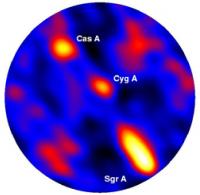
Commissioning observations made this past fall by the LWDA show its all sky imaging capability. In this frame from the LWDA first light movie, emission from the bright sources Sagittarius A at the center of our galaxy, Cassiopeia A, and the black-hole powered radio galaxy, Cygnus A, are all clearly visible. Cassiopeia A, the strongest discrete radio source visible in the sky, is a remnant of a massive star that exploded in a supernova over 300 years ago. Image courtesy Tracy Clarke, Interferometrics Inc.
(MAR 29) Astronomers at the Naval Research Laboratory (NRL) have produced the first images of the sky from a prototype of the Long Wavelength Array (LWA), a revolutionary new radio telescope to be constructed in southwestern New Mexico. More
(MAR 28) An odd, six-sided, honeycomb-shaped feature circling the entire north pole of Saturn has captured the interest of scientists with NASA's Cassini mission. More
The lift-off of a Target Launch Vehicle (TLV) March 20 provided observers at Vandenberg AFB with an impressive, though fleeting, display (click to enlarge) before the vehicle disappeared into low clouds. The launch exercised the Sea-Based X-Band Radar, a massive floating radar developed for the U.S. missile defense system. Copyright 2007, Brian Webb
(MAR 21) BLOOMINGTON, Ind. -- A telescope used by Indiana University astronomers and their colleagues at Kitt Peak National Observatory near Tucson, Ariz., is about midway through a major improvement -- the addition of a new kind of camera that will allow scientists to record the telescope's entire exceptionally wide field of view for the first time. More
(MAR 20) VANDENBERG AIR FORCE BASE, Calif. - An unarmed Minuteman II intercontinental ballistic missile was launched from North Vandenberg today at 9:27 p.m.
The mission tested the Missile Defense Agency's sensors.
Col. Teresa Djuric, 30th Space Wing vice commander, was the spacelift commander.
Representing MDA locally was Richard Vernetti acting as target mission director.
"This was another safe and successful launch for the 30th Space Wing, the Air Force and the Department of Defense," Colonel Djuric said.
U.S. Air Force
(MAR 20) The Air Force is predicting acceptable weather for tonight's launch of a target missile from Santa Barbara County ... the flight will test an ocean-going radar developed for the U.S. missile defense system. Listen
Courtesy KCLU public radio

This view of Saturn's moon Titan is part of an animation released March 13 by the Jet Propulsion Laboratory. The movie, comprised of several detailed images taken by Cassini's radar instrument, shows what are believed to be bodies of liquid near Titan's north pole. These seas are most likely liquid methane and ethane. JPL, a division of the California Institute of Technology in Pasadena, manages the mission for NASA's Science Mission Directorate, Washington, D.C. Image courtesy NASA/JPL
(MAR 13) PASADENA, Calif. -- In the outer reaches of the solar system, there is an object known as 2003 EL61 that looks like and spins like a football being drop-kicked over the proverbial goalpost of life. More
(MAR 12) VANDENBERG AIR FORCE BASE, Calif. - NASA's Aeronomy of Ice in the Mesosphere (AIM) spacecraft arrived Saturday at Vandenberg Air Force Base, Calif., for a targeted April 25 launch aboard a Pegasus XL rocket. More
Saharan dust was still blowing off the west coast of Africa and over the Cape Verde Islands when the MODIS instrument on NASA's Terra satellite captured this image (click to enlarge) on March 1. It shows a veil of dust over the Atlantic Ocean and the Cape Verde Islands. Saharan dust storms are regularly whipped out over the Atlantic by strong easterly winds near the Earth's equator. Terra was launched aboard an Atlas IIas rocket from California in 1999. Image courtesy Jeff Schmaltz MODIS Land Rapid Response Team, NASA GSFC
(MAR 7) Pasadena, Calif. -- Certain double, or binary, star systems erupt in full-blown explosions and then flare up with smaller bursts, according to new information gathered by NASA's Galaxy Evolution Explorer (GALEX) and analyzed by a team of astronomers, including postdoctoral researcher Mark Seibert of the Carnegie Observatories. More
(MAR 6) SCHRIEVER AIR FORCE BASE, Colo. (AFNEWS) -- As a satellite systems crew chief, Staff Sgt. Lori Browning has a job that is out of this world. She is currently receiving training on the Space Based Infrared Systems, or SBIRS, that is scheduled to become operational sometime next year. More
This beautiful image (click to enlarge) of spiral galaxy IC 342, taken under the dark skies of Kitt Peak National Observatory in Arizona, was released February 21 in Washington, D.C. The release occurred at the opening of the symposium "The Night: Why Dark Hours Are So Important,". The image, obtained in late 2006, was taken using the 64-megapixel Mosaic-1 digital imager on the Mayall 4-meter telescope. Image courtesy T.A. Rector/University of Alaska Anchorage, H. Schweiker/WIYN and NOAO/AURA/NSF
(FEB 28) REDONDO BEACH, Calif. - The Lunar Crater Observation and Sensing Satellite (LCROSS) successfully completed critical design review, giving Northrop Grumman Corporation (NYSE:NOC) the green-light to complete building flight hardware for the mission. More
(FEB 22) As populations and cities grow, our once pristine view of the stars is being whitewashed by urban glow. Astronomers, whose view of the heavens is being dimmed, are complaining, but biologists are also decrying light pollution ... More
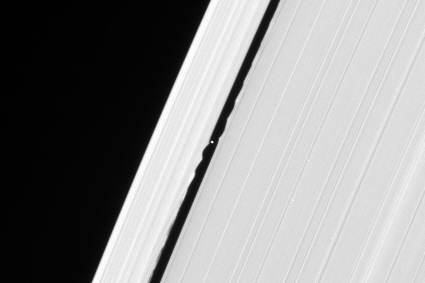
A Cassini spacecraft image released February 22 shows Saturn's moon Daphnis cruising through an area of the planet's rings called the Keeler Gap, raising edge waves in the ring material. The visible light image was taken by the craft's narrow-angle camera from a distance of approximately 477,000 miles (768,000 km) from Daphnis. The tiny moon is a mere 4.3 miles (7 km) across. The Cassini imaging operations center is based at the Space Science Institute in Boulder, Colo. Image courtesy NASA/JPL/Space Science Institute
(FEB 24) Bob Eklund of the Mount Wilson Observatory Association is hosting a star party at the Playa Vista Branch of the Los Angeles Public Library on Thursday, March 1. The event will be held from 6:00 to 8 p.m. and will feature views of the Moon, Venus, and Saturn and an overhead pass of the International Space Station.
All are welcome and there is no need to RSVP. However, Eklund asks that you call him at (310) 216-5947 if you can bring a telescope.
The Playa Vista Branch Library is located at 6400 Playa Vista Drive. To get there, take Jefferson Blvd. to Playa Vista Drive (one block east of Lincoln Blvd.). The library is south of Jefferson Blvd. on the east side of Playa Vista Drive. For more information, call (310) 437-6680
(FEB 21) PASADENA, Calif.--A team of astronomers led by Carl Grillmair of the California Institute of Technology has discovered some puzzling things about a Jupiter-sized planet that passes in front of a nearby star in the constellation Vulpecula. More
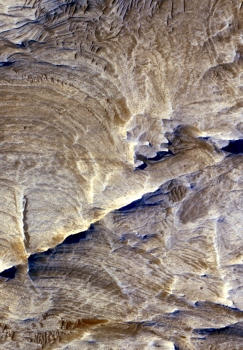
Fractures within Mars' Candor Chasma region retain ridge-like shapes as the surrounding rock erodes away in this Mars Reconnaissance Orbiter (MRO) image. This points to past episodes of fluid alteration along the fractures and reveals clues into past fluid flow and geochemical conditions below the surface. Scientists reported February 16 that observations by the MRO indicate that liquid or gas flowed through cracks penetrating underground rock on ancient Mars. These fluids may have produced conditions to support possible habitats for microbial life. Lockheed Martin Space Systems, Denver, is the prime contractor for the MRO project and built the spacecraft. Image courtesy NASA/JPL/Univ. of Arizona
(FEB 15) DENVER -- Quest Product Development and Ball Aerospace and Technologies have won a NASA grant to develop an advanced thermal insulation for long manned space missions. The Integrated Multilayer Insulation (IMLI) is expected to be two to three times better than the current best spacecraft insulation. More
(FEB 13) PASADENA, Calif. and CASCINA, Italy - The Laser Interferometer Gravitational-Wave Observatory (LIGO) and the Virgo interferometric gravitational-wave detector of the European Gravitational Observatory (EGO) near Pisa, Italy, have agreed to join in a collaborative search for gravitational waves from sources in and far beyond our galaxy. More
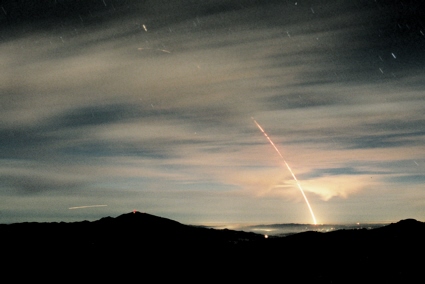
The February 7 launch of a Minuteman III ICBM from Vandenberg AFB is recorded in this 3-1/2 minute exposure. The Webmaster took the photo from the mountains north of Santa Barbara using a vintage film camera. Despite cloud cover from an approaching storm, much of the powered flight from liftoff through third stage cutoff is visible. The short streaks are star trails caused by the Earth's rotation. Copyright 2007, Brian Webb
(FEB 9) VANDENBERG AFB - A Global Positioning System (GPS) range tracking system, developed for the Minuteman III ICBM by Northrop Grumman, was successfully flown for the first time this week. More
(FEB 7) VANDENBERG AIR FORCE BASE, Calif. - An unarmed Minuteman III intercontinental ballistic missile was launched from North Vandenberg today at 12:14 a.m. More
(FEB 5) VANDENBERG AIR FORCE BASE, Calif. - An unarmed Minuteman III intercontinental ballistic missile is scheduled to launch from North Vandenberg Wednesday morning as an operational test to demonstrate the weapon system's reliability and accuracy. The six-hour launch window is from 12:01 to 6:01 a.m. PDT.
The missile will launch under the direction of the 576th Flight Test Squadron here.
Col. Jack Weinstein, 30th Space Wing commander, is the spacelift commander. Lt. Col. S. L. Davis, 576th FLTS commander, is the mission director for this launch.
Members of the 576th FLTS installed tracking, telemetry and command destruct systems on the missile to collect data and meet safety requirements.
The missile's single unarmed re-entry vehicle is expected to travel approximately 4,200 miles, hitting a pre-determined water target in the Marshall Islands.
The entire ICBM community, including the Department of Defense and the Department of Energy will use the data collected from this mission.
Vandenberg AFB news release
A rocket motor is put through its paces during a recent test firing (click image to enlarge) at SpaceDev's test site in southern Orange County, Calif. The firing was part of a series of three hot-fire tests of its hybrid upper stage motor, part of the SpaceDev Streaker™ Small Launch Vehicle development program. Image courtesy SpaceDev
(FEB 3) A close celestial gathering next week will give skywatchers a chance to spot three planets, two of which many people never see.
On February 7, Mercury attains its greatest separation from the Sun and will be visible low in the west at dusk. To find this diminutive planet, look in the west about 25 minutes after sunset and locate brilliant, silvery-white Venus. As seen from Los Angeles, the much fainter Mercury will be about 6° below and to the right of Venus.
Unlike Venus and Mercury, the third planet is too faint to see with the naked eye. Once the sky grows darker, observers with binoculars or a small telescope can use Venus to guide them to Uranus. Venus and Uranus will have a close encounter on the morning of February 7 and will be separated by about 3/4° at 18:00 PST that evening. Uranus will appear as a faint speck to Venus' immediate right at the 3 o'clock position.
(JAN 29) VANDENBERG AFB, Calif. -- The Defense Meteorological Satellite Program (DMSP) F-17 Block 5D-3 spacecraft, built under contract for the U.S. Air Force by Lockheed Martin [NYSE:LMT], has been turned over to the National Oceanic and Atmospheric Administration (NOAA) for operational use worldwide. More
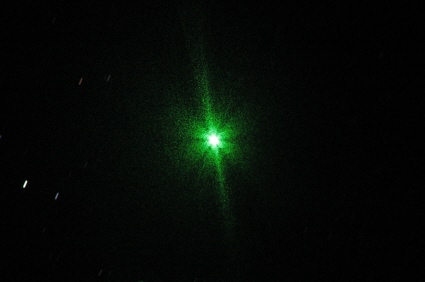
The fleeting flash from a laser aboard the CALIPSO spacecraft was captured in this January 22 image by satellite tracker Gregg Hendry. CALIPSO's laser fires downward 20 times per second to obtain profiles of atmospheric aerosols and clouds. To record this 20-nanosecond flash, Hendry positioned himself under the satellite's path near Nederland, Colorado; aimed his digital camera straight up; and took a time exposure. CALIPSO was launched aboard a Delta II rocket from Vandenberg AFB in 2006. Copyright 2007, Gregg Hendry. Used with permission.
(JAN 23) REDONDO BEACH, Calif. - Uplink and downlink phased array antennas developed by Northrop Grumman for the first Advanced Extremely High Frequency (EHF) military satellite communications payload have been successfully integrated onto the first flight structure. More
Both luminous and translucent, the C ring sweeps out of the darkness of Saturn's shadow and obscures the planet at lower left. The dark, inner B ring is seen at lower right. This visible light image (click to enlarge) was taken by the Cassini spacecraft on December 15 at a distance of approximately 393,000 miles (632,000 kilometers) from Saturn. The Cassini orbiter and its two onboard cameras were designed, developed and assembled at JPL in Pasadena, Calif. Image courtesy NASA/JPL/Space Science Institute
(JAN 18) New Mexico State University's Department of Astronomy will hold an open house at the campus observatory starting at 8 p.m. Friday, Jan. 26.
Weather permitting, participants will observe the moon, the Orion Nebula, the Pleiades Cluster and other interesting objects.
Astronomy personnel on hand will be faculty member Bernie McNamara and graduate students Jim Norwood, Ryan Campbell and Brandon Lawton.
The Tombaugh Observatory on the NMSU campus is located east of Williams Avenue, near the running track. Admission is free and children are welcome.
In the event of cloudy weather, the open house will be rescheduled for next month.
For more information call the astronomy department at (505) 646-4438.
New Mexico State University
(JAN 16) SANTA CRUZ, CA -- The Department of Energy (DOE) has awarded valuable computing time on one of the world's most powerful supercomputers to two research projects led by scientists at the University of California, Santa Cruz. More
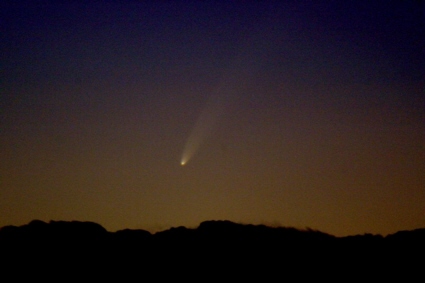
Comet McNaught provided a splendid, but fleeting display for skywatchers this week. The object was visible to the naked eye low in west after sunset for several evenings. Astrophotographer Jaw Lawson recorded this image of Comet McNaught on January 11 from Sparks, Nevada. Image Copyright 2007, Jay Lawson. Used with permission.
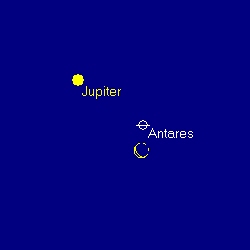
If you happen to be awake early on Monday, be sure to see the conjunction of the Moon, the star Antares, and Jupiter. To view the grouping, look low in the southeast about 45 minutes before sunrise. The graphic shows the positions of the objects from Los Angeles on January 15 at 06:10 PST (14:10 UTC). Chart courtesy of SkyMap
(JAN 8) CLEARFIELD, Utah - The U.S. Air Force, and its industry partner Northrop Grumman Corporation (NYSE:NOC), marked the initial deployment of the first Minuteman III carrying the MK21 reentry vehicle during a ceremony at the end of 2006 at Hill Air Force Base. More
NASA's Opportunity Mars rover captured this vista (click to enlarge) of Victoria Crater from Cape Verde, a promontory on the crater's rim. Opportunity drove onto Cape Verde shortly after arriving at Victoria's rim last September. The view combines hundreds of exposures taken by the rover's panoramic camera through infrared, green, and violet filters. It is presented in false color to emphasize differences among materials in the rocks and soils. The Opportunity mission is managed for NASA by the Jet Propulsion Laboratory. Image courtesy NASA/JPL-Caltech/Cornell
(JAN 5) CLEARFIELD, Utah - The Air Force has awarded Northrop Grumman a $15 million contract to continue modernization of the Minuteman III missile's fourth stage. The 22-month effort involves refurbishing and replacing aging flight hardware and ordnance. More
(JAN 4) Peterson Air Force Base, Colo. - NORAD and U.S. Northern Command are aware that a Russian SL-4 spacecraft launch stage from a commercial satellie launch re-entered the atmosphere over Wyoming through Colorado earlier this morning. More
Copyright © 2007-2016, Brian Webb. All rights reserved.